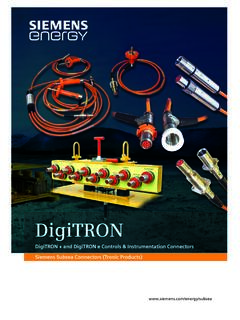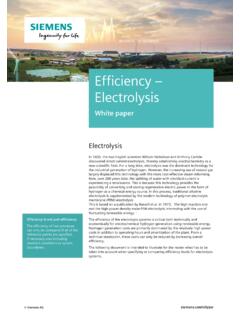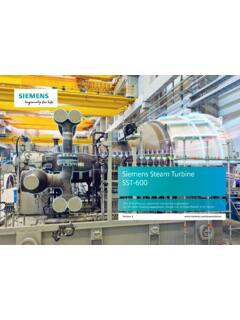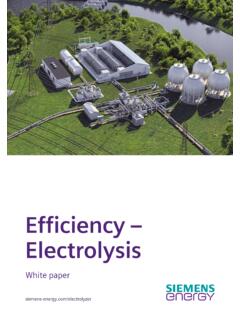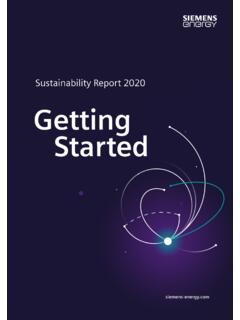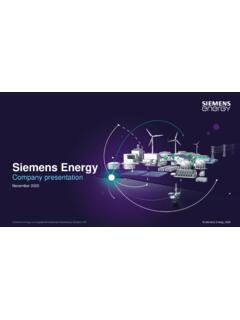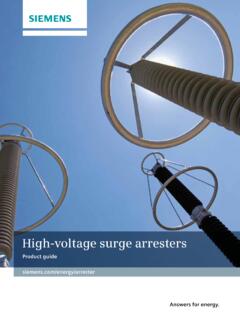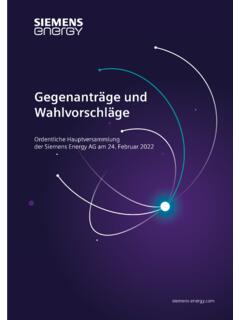Transcription of Hydrogen infrastructure – the pillar of energy transition
1 infrastructure the pillar of energy transitionThe practical conversion of long-distance gas networks to Hydrogen operationPage03 Executive Summary04 Foreword05 1. Hydrogen : overview Green Hydrogen as the energy source of the future07 2. Generation08 3. Transmission Intrinsic value of the existing gas infrastructure Pipeline capacity in the transition to Hydrogen Suitability of the pipelines for Hydrogen operation Compression requirements for transport14 4. Storage Existing gas storage capacities H2 readiness of German gas storage facilities16 5. Hydrogen industry in operation System start-up and first model projects Integration into the German and international gas market23 6 Economics Investment and production costs Legal framework24 7.
2 Summary / outlookAuthorsPeter Adam Siemens energy , GermanyFrank Heunemann Nowega GmbH, GermanyChristoph von dem Bussche Gascade Gastransport GmbH, GermanyStefan Engelshove Siemens energy , GermanyThomas Thiemann Siemens energy , Germany 2 Executive SummaryWithin the framework of energy sector integration and together with the expansion of the electricity grids, a needs-based Hydrogen infrastructure is a central building block for the reliable supply to industrial, public and private customers of CO2-free energy : Hydrogen can be produced by electrolysis with energy from renewable sources in large quantities and com-pletely CO2-free, stored, transported and made available via gas networks, and integrated into the international gas markets.
3 Pure Hydrogen , as an energy source in pipelines, has an almost comparable transport energy density as natural gas. It can therefore provide the market with the re-quired capacities for climate-neutral energy . The highly integrated German and European natural gas transmission networks represent an economically advan-tageous way to distribute large quantities of energy as required. The pipeline networks are available, socially accepted, and can be gradually converted to Hydrogen operation with an investment of an estimated 10-15% of the cost of new construction (calculations are based on general obersations and consumptions). The generation of Hydrogen based on renewable energy sources is subject to strong fluctuations.
4 Concrete model calculations show that the needs-based supply of customers via existing gas storage temporarily can be supplemented with blue Hydrogen . To increase the proportion of green Hydrogen , a consequent expansion of renewable electricity generation is required. The technologies for converting the gas infrastructure to Hydrogen operation are already largely available; the large-scale application at a high level of technical stan-dardization will foreseeably lead to economically sensible solutions. To establish a Hydrogen industry in line with the market, uniform and appropriate framework conditions are needed to ensure the competitiveness of climate-neutral Hydrogen on the energy market.
5 In parallel, the regulatory framework for the network must be adapted to enable Hydrogen transport using the publicly-accessible gas network. Various regional model projects for the establishment of Hydrogen economies with industrial customers are already being planned. An expansion of these model projects can form the basis for a Germany and Europe- wide Hydrogen industry by 2030. In developing and deploying a clean Hydrogen value chain, Europe will become a global front-runner and retain its leadership in clean tech Frans Timmermans, First Vice President of the European Commission, ) 3 ForewordEnergy transition presents all nations with major economic and logistical central question when converting to renewable energy sources is: how can the energy be effectively stored and made available?
6 As regenerative energy production is subject to strong natural fluctuations, powerful and needs-based storage and transport solutions are required to compensate for the inevitable energy -market differences. In contrast to the existing gas and electricity infrastructure , new construction of the necessary infrastructure is subject to elaborate and complex planning and approval establishment of a Hydrogen industry creates compara-tively cheap solutions to the above-mentioned challenges that can be implemented in the short term. Numerous countries, including those in the EU, have already identified Hydrogen as the energy source of the future in addition to expanding power grids to promote industrial decar- bonization, enable sector integration, and achieve climate as a source of energy per se is a storage medium.
7 Like natural gas, it can be stored in large underground storage facilities, transported to the end-user by pipeline, and even achieves a similarly high transport energy density due to its material Heunemann Managing Director Nowega GmbHThorbjoern Fors Executive Vice President Industrial Applications, Siemens EnergyChristoph von dem Bussche Managing Director Gascade Gastransport GmbHCountries like Germany also have extremely well-developed natural gas transmission networks that are well integrated with the international market. As current studies and prac-tice cases show, the existing networks can be converted to Hydrogen operation step by step and in a needs-oriented way with comparatively little effort notably without the complex procedural steps of new on real practice cases and from the perspective of technology companies and network operators, this paper examines what a German and European Hydrogen infra-structure could look like in practice based on the existing natural gas systems, what opportunities it offers, and what challenges must be overcome for a successful changeover.
8 41. Hydrogen : OverviewHydrogen is the most common element in the universe and, with molecular weight 2 ( kg/Nm3), the lightest of all gases. Its melting point is C. On earth, it occurs in a bonded form, mostly as water (H2O). Hydrogen is not toxic, not corrosive, not self-igniting, and burns to water vapor without the emission of has a low energy density (3 kWh/Nm3) due to its extremely low weight (compared to methane: 10 kWh/Nm3), but its calorific value is significantly higher at around 33 kWh/kg (methane: 14 kWh/kg). Compression allows the energy density to be increased to a level comparable to that of natural gas2). As a gas, Hydrogen can be transported in large quantities in pipelines and stored in gas storage facilities.
9 As an energy source, Hydrogen can be used in industry and by end users in fuel cells for mobility and heating applications or it can be used to generate electricity in turbines. At the same time, it serves as a raw material and resource for numerous industrial can be generated in different ways from gray , CO2-intensively obtained, via CO2-neutral blue , to CO2-free green Hydrogen from renewable energy public discussion, types of Hydrogen are often simply given colors that refer to the CO2 balance of their production. In the context of the present analysis, according to this color theory (in addition to other forms of production), green , gray and blue Hydrogen are particularly relevant: Green Hydrogen is produced by water electrolysis: water is split into Hydrogen and oxygen by an electric current and with the help of an electrolyte.
10 If the electricity required for electrolysis comes exclusively from renewable, CO2-free sources, the entire pro-duction process is completely CO2-free. Blue Hydrogen is generated CO2-neutral from fossil fuels. The CO2 is separated and stored or reused (Carbon Capture and Storage (CCS) or Carbon Capture Usage (CCU)). Gray Hydrogen is obtained from fossil fuels. For example, natural gas is converted under heat into Hydrogen and CO2 ( steam reforming ). Approximately nine tons of CO2 are generated to produce one ton of Hydrogen from : categorized according to the CO2 balanceVeribus dolorpro | Rubrik, Artikel Green Hydrogen as the energy source of the futureWith its completely CO2-free production, green Hydrogen offers the potential for permanent decarbonization of the energy landscape and compliance with climate goals.
